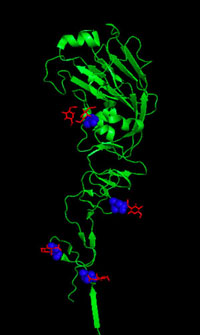
Tad Kaczynski
The State University of New York, University at Buffalo
Sasisekharan Lab
Mentor: Akila Jayaraman
Summer 2009
Role of Protein Glycosylation in Receptor Binding Properties of Influenza A Virus Hemagglutinin
The influenza A virus has been responsible for three major epidemics of the 20th century, as well as continual seasonal infections. One of the critical steps of human infection is the binding of the virus to the glycan receptors on the epithelial cells of the human upper-respiratory-tract. This binding is mediated by the viral coat protein hemagglutinin (HA). The HA from human adapted influenza A virus binds to ?2-6 sialylated glycan receptors on the surface of the tracheal epithelial cells. HA is itself a glycosylated protein, and while these oligosaccharides have been implicated in viral immune escape, it remains unknown as to whether or not they are involved in the HA binding to the ?2-6 sialylated glycans. Hence we analyzed the role of conserved HA glycosylation sites in mediating HA binding to the glycan receptor. Conserved glycosylation sites for each HA subtype (H1N1, H2N2, and H3N2) were determined using bioinformatics and modeling tools. For the H1N1 subtype, a single conserved glycosylation site located near the HA receptor binding site was chosen as a possible candidate in binding specificity. A mutant H1N1 HA protein that lacked the chosen glycosylation site was created by site-directed mutagenesis. Some preliminary studies were conducted to characterize the binding of the mutant HA to the human tracheal and alveolar tissues. There was a loss of binding to the tracheal epithelial cells that predominately express ?2-6 sialylated glycan receptors. To validate this further, we are currently performing binding studies on the glycan array as well as circular dichroism studies.
